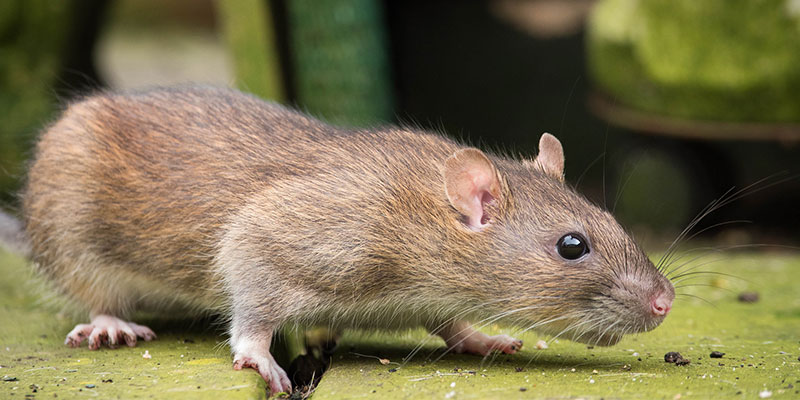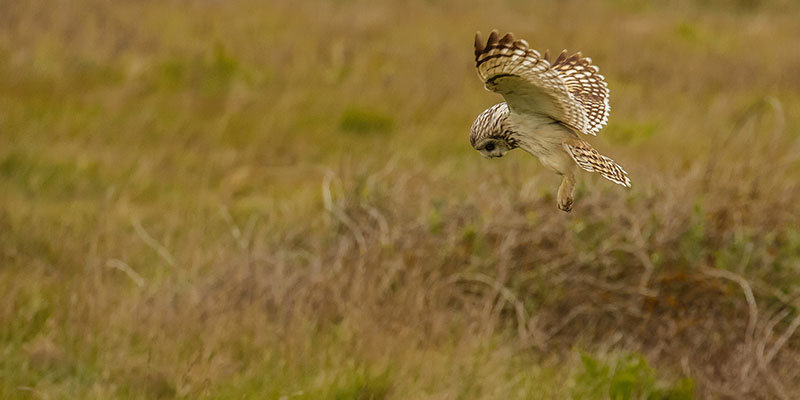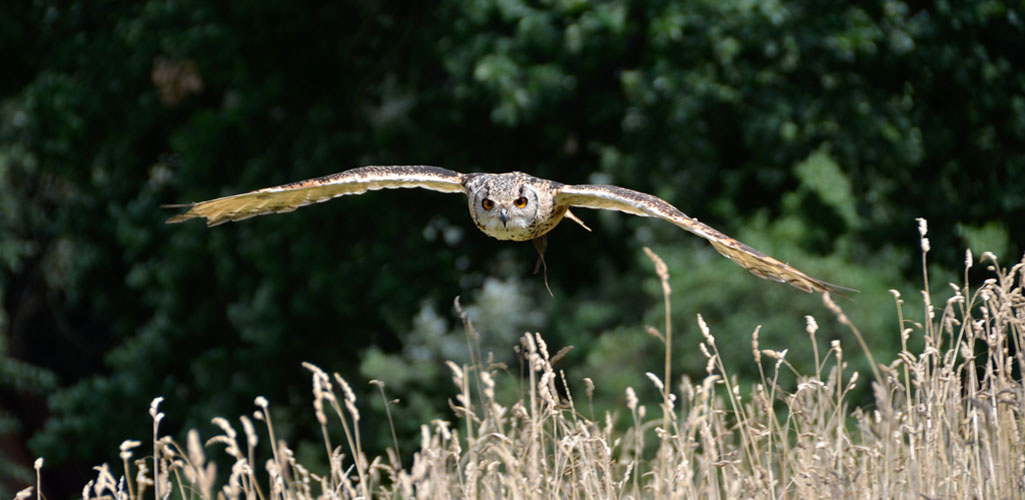Poisons and bait are a commonly used product to control the populations of many species that are considered pests. The problem with these methods of pests control is that it often ends up getting consumed by unintentional victims.
Primary Risk: The risk for a target or nontarget animal after initially consuming the poison. (Example: A rat eating poison)

Rodenticides are made with the goal to attract target animals to consume the bait. They are purposefully created to smell and taste appealing to a variety of targeted wildlife. Loose bait has the highest risk since any wildlife can gain access to it but bait stations cannot always prevent nontarget animals from being affected. Many invertebrates (such as cockroaches) aren’t affected by anticoagulant poisons but have the potential to scatter bait material and/or cause secondary poisoning if another animal were to consume the invertebrate.
Secondary Risk: The risk for a target or nontarget animal after consuming another animal that initially consumed the poison. (Example: An owl eating a rat that ate poison)

Some of these poisons may require the animal to visit the bait station several times to consume enough bait for a lethal dose. Other poisons may only require a single dose but instead only become lethal after a certain length of time. The problem is that this allows the target wildlife to leave the bait station and possibly become another animal’s dinner. When predatory animals (such as owls) consume rodents that have consumed poison, they too become poisoned. And when that owl consumes enough poisoned rodents, that owl becomes the casualty of secondary poisoning.
There are two categories of rodenticides used to control populations of small mammals such as moles and rodents. These can be purchased at many retail stores and are easily obtained by the average consumer.
Anticoagulant Rodenticides
First Generation Anticoagulant Rodenticides (FGARs): Requires rodents and other small pests to consume the poison over a course of several feedings to deliver a lethal dose. These poisons can be metabolized by mammals quickly (being removed from the body within a week on average). (Mid = Moderate)
| Name | Primary Risk | Secondary Risk |
|---|---|---|
| Chlorophacinone | Low (birds, mammals) | Low (birds), High (mammals) |
| Diphacinone | Low (birds, mammals) | Mid (birds), High (mammals) |
| Warfarin | Low (birds), Mid (mammals), High (cats) | Mid (birds, mammals) |
Second Generation Anticoagulant Rodenticides (SGARs): Much more potent than first generation and can deliver a lethal dose after a single feeding. These poisons are not metabolized easily and buildup in the liver and other organs. These poisons are more likely to cause severe poisoning in nontarget wildlife, pets, and children due to the nature of these poisons.
| Name | Primary Risk | Secondary Risk |
|---|---|---|
| Brodifacoum | High (birds, mammals) | High (birds), High (mammals) |
| Bromadiolone | Mid (birds), High (mammals) | Mid (birds, mammals) |
| Difethialone | High (birds), Mid (mammals) | High (birds), Mid (mammals) |
| Difenacoum | Mid (birds), High (mammals) | Mid (birds), Unknown (mammals) |
Non-Anticoagulant Rodenticides
Cholecalciferol (vitamin D3): Works by increasing the calcium and phosphorus levels in the body and typically results in heart problems and secondary kidney failure. Typically requires multiple doses or a very strong initial dose.
Bromethalin: Only requires a single dose. Targets the central nervous system and results in respiratory distress.
Zinc, calcium, and aluminum phosphides: Only requires a single dose. Turns into phosphine gas when it interacts with stomach acid. It targets the body’s cells by blocking their ability to make energy, and so the cells die. It is most damaging to the major organs in the body (heart, brain, kidney, and liver).
| Name | Primary Risk | Secondary Risk |
|---|---|---|
| Cholecalciferol (vitamin D3) | Low to Mid (birds, mammals) | Low (birds, mammals) |
| Bromethalin | Low (birds, mammals) | Low (birds, mammals) |
| Phosphides | High (birds, mammals) | Low (birds, mammals) |
Nontarget Casualties
The unfortunate reality of using rodenticides is that many nontarget wildlife are often exposed and become casualties of rodenticide use. The biggest threats to predatory wildlife (and even pets) are anticoagulant rodenticides. The good news is that many cities are banning the sale of anticoagulant rodenticides.
Poison-Free Alternatives to Pest Control
There are very few situations where rodenticides are the only way to control a rodent problem. Many times you can slow down or stop problem animals just by making your area less attractive. Make sure that you aren’t contributing to the rodent problem by following these steps:
- Don’t leave pet food outside. Pet food attracts all sorts of wildlife, including rodents and raccoons.
- Keep pet food (and people food for that matter) indoors in sealed containers. Open food containers attract more than just rodents. It also attracts ants and other unwanted creatures.
- Check the air vents around your house to see if there are any gaps or areas that aren’t properly covered.
- Seal up any gaps and use wire mesh to cover up any holes. This will prevent wildlife from entering your house.
- Just remember that a rat can squeeze through a hole the size of a quarter, and a mouse can squeeze through a hole smaller than a dime.
- Use squirrel/rat proof bird feeders and attempt to keep the area clean. Make sure you keep bird seed inside in sealed containers.
- Don’t leave trash outside (especially don’t leave trash out in plastic bags). Keep trash in city-issued garbage bins and secure it when not being put out for collection.
When prevention isn’t enough to stop the problem than consider some of these non-toxic alternatives.

Snap Traps
- A snap trap is quick and simple. It can instantly kill the target animal and doesn’t harm any other wildlife that may see the caught animal as a meal.
- Make sure to wear gloves when emptying the trap.
Electronic Traps
- It works by electrifying the animal when it enters the bait box. It is too small for many nontarget animals to enter but large enough for rats. It is quick and easy to set up and they typically have a blinking light when an animal has been caught inside.
Glue Traps
- These are not recommended and are less humane than other traps since they don’t kill the animal. If the traps aren’t checked often enough, the animal may starve or become dehydrated and this causes prolonged suffering.
Live Traps
- Due to the health risks associated with handling live rodents this is not recommended.
Attracting Predatory Birds
- Attracting owls to an area may be a slow way to curb the rodent population but once they are established in an area they can have a big impact on rodent populations.
- Attracting owls to an area may be a slow way to curb the rodent population but once they are established in an area they can have a big impact on rodent populations.
Call a Professional
- When you are overwhelmed and aren’t sure how to handle the problem, the best thing you can do is call a professional. They may be able to better identify where the problem is originating from and may be able to more effectively stop wildlife from entering your house. Many pest companies understand how to effectively remove wildlife without risk of exposure to pets and children.
Additional Resources
Predator Control as a Tool in Wildlife Management http://texnat.tamu.edu/files/2010/08/PredatorControlforWildlifeMgt.pdf
Urban Carnivores http://www.urbancarnivores.com/poisons/
Pet Safe Rodent Control http://www.earthkind.com/how-to-use/pet-safe-rodent-control
Check out our facebook page for more content on Urban Wildlife and please post your photos and stories about the wildlife you have in your backyard! Also feel free to let us know what you think about this or any of our articles by commenting on our facebook page!
References
Airhart, E. (2017, May 15). Rat remedy frozen in legislation. Retrieved May 24, 2017, from http://scienceline.org/2017/05/rat-remedy-frozen-legislation/
Erickson, W. A., & Urban, D. J. (2004). Potential risks of nine rodenticides to birds and nontarget mammals: a comparative approach (p. 225). Washington, DC: US Environmental Protection Agency, Office of Prevention, Pesticides and Toxic Substances. Retrieved May 13, 2017, from http://pesticideresearch.com/site/docs/bulletins/EPAComparisonRodenticideRisks.pdf
Greenlee, E. (2014, December 09). Rodenticides: Top 4 ingredients that kill pets. Retrieved May 13, 2017, from http://veterinaryteam.dvm360.com/rodenticides-top-4-ingredients-kill-pets
Safe Rodent Control. (2016). Risks for Wildlife. Retrieved May 24, 2017, from http://saferodentcontrol.org/site/wildlife/
Safe Rodent Control. (2016). Rodenticides: Background & Hazards. Retrieved May 14, 2017, from http://saferodentcontrol.org/site/problems-with-rodenticides/
